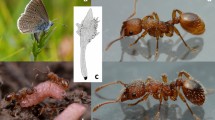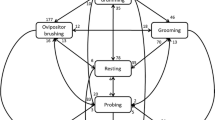Abstract
Vespa orientalis F. (Hymenoptera: Vespidae), a major pest of apiculture, indirectly disrupts pollination of fruit and vegetable crops, and constitutes a public health menace. Control methods are imperfect, labor-intensive, and entail the use of medically and environmentally dangerous chemicals. A parasitic wasp,Sphecophaga vesparum Curtis (Hymenoptera: Vespidae), has been found to attack a large proportion (up to 100%) of observedV. orientalis nests in southern Israel. Within these nests, 2.5–95.1% of host cells were parasitized by three to seven individuals. Heavily parasitized nests showed considerable reductions in the proportion of queen cells.
Similar content being viewed by others
References
Akre, R.D. and Mayer, D.F. (1994) Bees and Vespine wasps.Bee World 75: 29–37.
Avidov, Z. and Harpaz, I. (1969) Plant Pests of Israel. Israel Universities Press, Jerusalem.
Barr-Nea, L., Rosenberg, P. and Ishay, J. (1976) The venom apparatus ofVespa orientalis: morphology and cytology.Toxicon 14: 65–68.
Beggs, J.R., Alspach, P.A., Moller, H., Toft, R.J. and Tilley, J.A.V. (1992) Impacts of the parasitoidSphecophaga vesparum on colonies of the common wasp (Vespula vulgaris).Proc. 41st Annu. Conf. Entomological Society of New Zealand.
Bodenheimer, F.S. (1951) Citrus Entomology in the Middle East. W. Junk, The Hague, the Netherlands.
Bytinski-Salz, H. and Gusenleiter, J. (1971) The Vespoidea of Israel.Israel J. Entomol. 6: 239–299.
Chang, V. (1988) Toxic baiting of the western yellowjacket (Hymenoptera: Vespidae) in Hawaii.J. Econ. Entomol. 81: 228–235.
Clausen, C.P. (1940) Entomophagous Insects. McGraw-Hill Book Co., New York, NY.
Dan, J., Gerson, R., Koyumdjinski, H. and Yaalon, D.H. (1981) Aridic Soils of Israel: Properties, Genesis and Management.Spec. Publ. Agric. Res. Orgn, Bet Dagan 190.
Davis, H.G., Zwick, R.W., Rogoff, W.M., McGovern, T.P. and Beroza, M. (1973) Perimeter traps baited with synthetic lures for suppression of yellowjackets in fruit orchards.Environ. Entomol. 2: 569–571.
Donovan, B.J. (1991) Life cycle ofSphecophaga vesparum (Curtis) (Hymenoptera: Ichneumonidae), a parasitoid of some vespid wasps.N. Z. J. Zool. 18: 182–192.
Donovan, B.J. and Read, P.E.C. (1987) Attempted biological control of social wasps,Vespula spp. (Hymenoptera: Vespidae) withSphecophaga vesparum (Curtis) (Hymenoptera: Ichneumonidae) in New Zealand.N. Z. J. Zool. 14: 329–335.
Donovan, B.J., Moller, H., Read, P.E.C. and Tilley, J.A.V. (1989) Release and recovery of the introduced wasp parasitoid,Sphecophaga vesparum (Curtis) (Hymenoptera: Ichneumonidae), in New Zealand.N. Z. J. Zool. 16: 355–364.
Edwards, R. (1980) Social Wasps: Their Biology and Control. Rentokil Ltd., Sussex, UK.
Ennik, F. (1973) Abatement of yellow jackets by encapsulated formulations of diazinon and rabon.J. Econ. Entomol. 66: 1097–1098.
Gauss, R. (1968) Ueber Parasiten bei sozialen Wespen (Vespidae).Z Angew. Entomol. 61: 453–454.
Grant, C.D., Rogers, C.J. and Lauret, T.H. (1968) Control of ground-nesting yellow jackets with toxic baits — a five year testing program.J. Econ. Entomol. 61:1653–1656.
Ishay, J., Bytinski-Salz, H. and Shulov, A. (1967) Contributions to the bionomics of the Oriental hornet (Vespa orientalis Fab.).Isr. J. Entomol. 2: 106–115.
Ishay, J., Levanon, D., Avidor, N. and Shechter, O.S. (1983) Photo-periodicity stimulates cell size and caste determination in the Oriental hornetVespa orientalis Linne, 1775.Insectes Soc. 30: 332–346.
Klein, Z. and Slabezki, Y. (1994) The Oriental hornet and its control with a new chemical.Hassadeh 74: 900–901(Hebrew, with English summary).
Moller, H., Plunkett, G.M., Tilley, J.A.V., Toft, R.J. and Beggs, J.R. (1991) Establishment of the wasp parasitoidSphecophaga vesparum (Hymenoptera: Vespidae) in New Zealand.N. Z. J. Zool. 18: 199–208.
Spradbery, J.P. (1973) Wasps. An account of the biology and natural history of social and solitary wasps. Sidgwick and Jackson, London, UK.
Zangvil, A. and Druian, P. (1990) Upper air trough axis orientation and the spatial distribution of rainfall over Israel.Int. J. Climatol. 10: 57–62.
Author information
Authors and Affiliations
Rights and permissions
About this article
Cite this article
Havron, A., Margalith, Y. Parasitization ofVespa orientalis nests bySphecophaga vesparum curtis in Southern Israel (Hymenoptera: Vespidae, Ichneumonidae). Phytoparasitica 23, 19–25 (1995). https://doi.org/10.1007/BF02980392
Received:
Issue Date:
DOI: https://doi.org/10.1007/BF02980392




